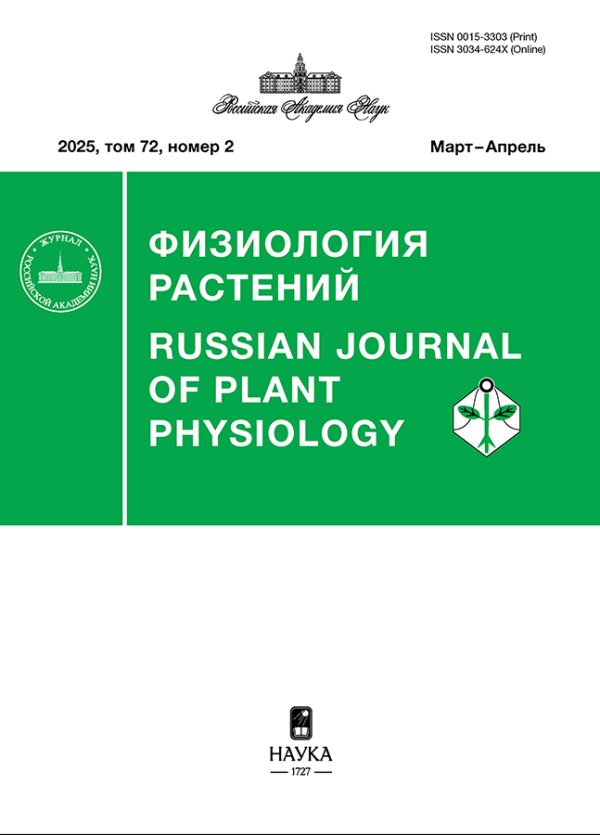Comparative analysis of the composition of sterols in embryogenic and nonembryogenic cell lines of Larix sibirica Ledeb.
- Authors: Semenova N.V.1, Shmakov V.N.1, Konstantinov Y.M.1, Dudareva L.V.1
-
Affiliations:
- Siberian Institute of Plant Physiology and Biochemistry, Siberian Branch, Russian Academy of Sciences
- Issue: Vol 70, No 2 (2023)
- Pages: 181-191
- Section: ЭКСПЕРИМЕНТАЛЬНЫЕ СТАТЬИ
- URL: https://journals.rcsi.science/0015-3303/article/view/130201
- DOI: https://doi.org/10.31857/S0015330322600516
- EDN: https://elibrary.ru/GKWEZO
- ID: 130201
Cite item
Full Text
Abstract
The cell lines of Siberian larch (Larix sibirica Ledeb.), possessing different embryogenic potential, were studied. Qualitative and quantitative content of sterol components was comparatively analyzed in their tissues with the help of gas chromatography-mass spectrometry. Significant differences in these parameters were found between both groups of the lines in fractions of free sterols and their esters. In addition to sterol compounds, squalen, which is a triterpenic intermediate in sterol biosynthesis, was revealed. Of free sterols, β-sitosterol, campesterol, isofucosterol, and stigmasterol dominated in the embryogenic lines, while β-sitosterol, campesterol, and stigmasterol in nonembryogenic ones. The campesterol concentration was 1.3–1.9 times higher in the embryogenic than nonembryogenic lines. Since campesterol is a precursor of brassinosteroids, it is likely that its level is high due to an embryogenic state of these cell lines. Only the embryogenic lines contained appreciable amounts of isofucosterol. The fraction of sterol esters exhibited wider component diversity in the nonembryogenic than the embryogenic lines. In all the cell lines, among the identified sterol esters, the substances without double bonds, bearing, as a structural fragment, a sterane core—perhydrocyclopenta[a]phenanthrene—were the most abundant. Their content ranged from 52 to 71% of the total amount of sterol esters. The revealed differences in the compositions of sterols and their esters, between the L. sibirica cell lines with different embryogenic potential, witness to the considerable rearrangements in sterol metabolism in the course of embryogenesis. The line-specific differences may indicate the involvement of these metabolites in formation of embryos.
Keywords
About the authors
Natalia V. Semenova
Siberian Institute of Plant Physiology and Biochemistry, Siberian Branch, Russian Academy of Sciences
Author for correspondence.
Email: tashasemyonova@mail.ru
Russian Federation, Irkutsk
Vladimir N. Shmakov
Siberian Institute of Plant Physiology and Biochemistry, Siberian Branch, Russian Academy of Sciences
Email: tashasemyonova@mail.ru
Russian Federation, Irkutsk
Yurii M. Konstantinov
Siberian Institute of Plant Physiology and Biochemistry, Siberian Branch, Russian Academy of Sciences
Email: tashasemyonova@mail.ru
Russian Federation, Irkutsk
Lyubov V. Dudareva
Siberian Institute of Plant Physiology and Biochemistry, Siberian Branch, Russian Academy of Sciences
Email: tashasemyonova@mail.ru
Russian Federation, Irkutsk
References
- Третьякова И.Н., Ворошилова Е.В., Шуваев Д.Н., Пак М.Э. Перспективы микроклонального размножения хвойных в культуре in vitro через соматический эмбриогенез // Хвойные бореальной зоны. 2012. Т. 30. С. 180.
- Tretiakova I.N. Embryogenic cell lines and somatic embryogenesis in an vitro culture of Siberian larch // Dokl. Biol. Sci. 2013. V. 450. № 1. P. 139. https://doi.org/10.1134/S0012496613030034
- Joy R.W., Yeung E.C., Kong L., Thorpe T. Development of white spruce somatic embryos: I. Storage product deposition // In Vitro Cell. Dev. Biol. – Plant. 1991. V. 27. P. 32.
- Tranvan H.O.A., Troton D., Calvayrac R. Morphological, histological and lipid changes during adventitious budding in Pinus pinaster cultured cotyledons // J. Exp. Bot. 1988. V. 39. № 7. P. 907. https://doi.org/10.1093/jxb/39.7.907
- Makarenko S.P., Shmakov V.N., Dudareva L.V., Stolbikova A.V., Semenova N.V., Tret’yakova I.N., Konstantinov Yu.M. Fatty acid composition of total lipids in embryogenic and nonembryogenic callus lines of larch // Russ. J. Plant Physiol. 2016. V. 63. №. 2. P. 252. https://doi.org/10.1134/S1021443716020102
- Семёнова Н.В., Шмаков В.Н., Пак М.Э., Третьякова И.Н., Константинов Ю.М., Дударева Л.В. Особенности состава нейтральных липидов эмбриогенных и неэмбриогенных клеточных линий Larix sibirica Ledeb. // Биологические мембраны. 2020. Т. 37. С. 215. https://doi.org/10.31857/S0233475520020127
- Semenova N.V., Shmakov V.N., Konstantinov Yu.M., Dudareva L.V. Phospholipids of embryogenic and non-embryogenic cell lines of Larix sibirica Ledeb. // Russ. J. Plant Physiol. 2020. V. 67. P. 1076. https://doi.org/10.1134/S1021443720060151
- Valitova J.N., Sulkarnayeva A.G., Minibayeva F.V. Plant sterols: Diversity, biosynthesis, and physiological functions // Biochemistry (Moscow). 2016. V. 81. P. 819. https://doi.org/10.1134/S0006297916080046
- Kreis W., Muller-Uri F. Biochemistry of sterols, cardiac glycosides, brassinosteroids, phytoecdysteroids and steroid saponins // Ann. Plant Rev. 2010. V. 40. P. 304. https://doi.org/10.1002/9781444320503.ch6
- Willmann M.R. Sterols as regulators of plant embryogenesis // Trends Plant Sci. 2000. V. 5. № 10. P. 416. https://doi.org/10.1016/S1360-1385(00)91717-5
- Hartmann M.A. Plant sterols and the membrane environment // Trends Plant Sci. 1998. V. 3. № 5. P. 170. https://doi.org/10.1016/S1360-1385(98)01233-3
- Senthill-Kumar M., Wang K., Mysore K.S. AtCYP710A1 gene emediated stigmasterol production plays a role in imparting temperature stress tolerance in Arabidopsis thaliana // Plant Signal. Behav. 2013. V. 8. № 2. P. e23142-1. https://doi.org/10.4161/psb.23142
- Schaller H. The role of sterols in plant growth and development // Prog. Lipid Res. 2003. V. 42. № 3. P. 163. https://doi.org/10.1016/S0163-7827(02)00047-4
- Bajguz A., Chmur M., Gruszka D. Comprehensive overview of the Brassinosteroid biosynthesis pathways: substrates, products, inhibitors, and connections // Front. Plant Sci. 2020. V. 11. P. 1034. https://doi.org/10.3389/fpls.2020.01034
- Clouse S.D. Brassinosteroid signal transduction: from receptor kinase activation to transcriptional networks regulating plant development // Plant Cell. 2011. V. 23. № 4. P. 1219. https://doi.org/10.1105/tpc.111.084475
- Tian X., Xuan L., Liu B., Hu T., Wang C., Wang X. Effects of heterologous expression of Populus euphratica brassinosteroids biosynthetic enzyme genes CPD (PeCPD) and DWF4 (PeDWF4) on tissue dedifferentiation and growth of Arabidopsis thaliana seedlings // Plant Cell Tissue Organ Cult. 2018. V. 132. № 1. P. 111. https://doi.org/10.1007/s11240-017-1316-2
- Nolan T., Chen J., Yin Y. Cross-talk of Brassinosteroid signaling in controlling growth and stress responses // Biochem. J. 2017. V. 474. № 16. P. 2641. https://doi.org/10.1042/BCJ20160633
- Zu S.H., Jiang Y.T., Hu L.Q., Zhang Y.J., Chang J.H., Xue H.W., Lin W.H. Effective modulating Brassinosteroids signal to study their specific regulation of reproductive development and enhance yield // Front. Plant Sci. 2019. V. 10. P. 1. https://doi.org/10.3389/fpls.2019.00980
- Schrick K. Mayer U., Martin G., Bellini C., Kuhnt C., Schmidt J., Jurgens G. Interactions between sterol biosynthesis genes in embryonic development of Arabidopsis // Plant J. 2002. V. 31. № 1. P. 61. https://doi.org/10.1046/j.1365-313X.2002.01333.x
- Schrick K., Cordova C., Li G., Murray L., Fujioka S. A dynamic role for sterols in embryogenesis of Pisum sativum // Phytochem. 2011. V. 72. № 6. P. 465. https://doi.org/10.1016/j.phytochem.2011.01.009
- Cunha A., Ferreira M.F. Differences in free sterols content and composition associated with somatic embryogenesis, shoot organogenesis and calli growth of flax // Plant Sci. 1997. V. 124. P. 97. https://doi.org/10.1016/S0168-9452(97)04587-1
- Zur I., Skoczowski A., Niemczyk E., Dubert F. Changes in the composition of fatty acids and sterols of membrane lipids during induction and differentiation of Brassica napus (var. oleifera L.) callus // Acta Physiol. Plant. 2002. V. 24. № 1. P. 3. https://doi.org/10.1007/s11738-002-0015-7
- Silvestro D., Andersen T.G., Schaller H., Jensen P.E. Plant sterol metabolism. ∆7-Sterol-C5-desaturase (STE1/DWARF7), ∆5,7-sterol-∆7-reductase (DWARF5) and ∆24-sterol-∆24-reductase (DIMINUTO/DWARF1) show multiple subcellular localizations in Arabidopsis thaliana (Heynh) L. // PLOS One. 2013. V. 8. P. 1. https://doi.org/10.1371/journal.pone.0056429
- Дударева Л.В., Семенова Н.В., Нохсоров В.В., Рудиковская Е.Г., Петров К.А. Компонентный состав фитостеринов надземной части хвоща пестрого Еquisétum variegatum Schleich. ex. Web., произрастающего в cеверо-восточной Якутии // Химия растительного сырья. 2020. № 2. С. 133. https://doi.org/10.14258/jcprm.2020025555
- Uchida H., Ohyama K., Suzuki M., Yamashita H., Muranaka T., Ohyama K. Triterpenoid levels are reduced during Euphorbia tirucalli L. callus formation // Plant Biotechnol. 2010. V. 27. № 1. P. 105. https://doi.org/10.5511/plantbiotechnology.27.105
- Chiu P.L., Bottino P.J., Patterson G.W. Sterol composition of nystatin and amphotericin B resistant tobacco calluses // Lipids. 1980. V. 15. №. 1. P. 50. https://doi.org/10.1007/BF02534118
- Deng S., Wei T., Tan K., Hu M., Li F., Zhai Y., Ye Sh., Xiao Y., Hou L., Luo M. Phytosterol content and the campesterol: sitosterol ratio influence cotton fiber development: role of phytosterols in cell elongation // Sci. China Life Sci. 2016. V. 59. № 2. P. 183. https://doi.org/10.1007/s11427-015-4992-3
- Qian P., Han B., Forestier E., Hu Z., Gao N., Lu W., Shaller H., Li J., Hou S. Sterols are required for cell fate commitment and maintenance of the stomatal lineage in Arabidopsis // Plant J. 2013. V. 74. № 6. P. 1029. https://doi.org/10.1111/tpj.12190
- Carland F.M., Fujioka Sh., Takatsuto S., Yoshida Sh., Nelson T. The identification of CVP1 reveals a role for sterols in vascular patterning // Plant Cell. 2002. V. 14. P. 2045. https://doi.org/10.1105/tpc.003939
- Ines C., Corbacho J., Paredes M.A., Labrador J., Cordeiro A.M., Gomez Jimenez M.C. Regulation of sterol content and biosynthetic gene expression during flower opening and early fruit development in olive // Physiol. Plant. 2019. V. 167. № 4. P. 526. https://doi.org/10.1111/ppl.12969
- Schaeffer A., Bouvier-Nave P., Benveniste P., Schaller H. Plant sterol-C24-methyl transferases: different profiles of tobacco transformed with SMT1 or SMT2 // Lipids. 2000. V. 35. № 3. P. 263. https://doi.org/10.1007/s11745-000-0522-1
- Valitova J., Renkova A., Mukhitova F., Dmitrieva S., Beckett R.P., Minibayeva F.V. Membrane sterols and genes of sterol biosynthesis are involved in the response of Triticum aestivum seedlings to cold stress // Plant Physiol. Biochem. 2019. V. 142. P. 452. https://doi.org/10.1016/j.plaphy.2019.07.026
- Dyas L., Prescott M.C., Evershed R.P., Goad L.J. Steryl esters in a cell suspension culture of celery (Apium graveolens) // Lipids. 1991. V. 26. № 7. P. 536. https://doi.org/10.1007/BF02536600
- Sharma P., Patil A., Patil D. Quantification of β-sitosterol from field grown plants and callus of Crataeva tapia L. // Int. J. Pharm. Sci. 2016. V. 7. № 4. P. 1556. https://doi.org/10.13040/IJPSR.0975-8232.7(4).1556-63
- Третьякова И.Н., Иваницкая А.С., Пак М.Э. Продуктивность эмбриогенных клеточных линий и их сомаклональная изменчивость у лиственницы сибирской in vitro // Лесоведение. 2015. №. 1. С. 27.
- Sonawane P.D., Pollier J., Panda S., Szymanski J., Massalha H., Yona M., Unger T., Malitsky S., Arendt Ph., Pauwels L., Almekias-Siegl E., Rogachev I., Meir S., Cardenas P.D., Athar M. et al. Plant cholesterol biosynthetic pathway overlaps with phytosterol metabolism // Nat. Plants. 2016. V. 3. № 1. P. 1. https://doi.org/10.1038/nplants.2016.205
- Lozano-Grande M.A., Gorinstein S., Espitia-Rangel E., Dávila-Ortiz G., Martínez-Ayala A.L. Plant sources, extraction methods, and uses of squalene // Int. J. Agron. 2018. V. 2018. P. 1. https://doi.org/10.1155/2018/1829160
- Iheagwam F.N., Israel E.N., Kayode K.O., De Campos O.C., Ogunlana O.O., Chinedu S.N. GC-MS analysis and inhibitory evaluation of Terminalia catappa leaf extracts on major enzymes linked to diabetes // Evid. Based Complement. Alternat. Med. 2019. V. 2019. P. 1. https://doi.org/10.1155/2019/6316231
- Nagalakshmi M.A.H., Murthy K.S.R. Phytochemical profile of crude seed oil of Wrightia tinctoria R. BR. and Wrightia arborea (DENNST.) MABB. by GC-MS // Int. J. Pharm. Sci. Rev. Res. 2015. V. 31. P. 46.
Supplementary files










